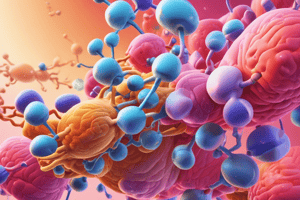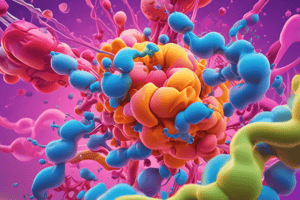Podcast
Questions and Answers
Which reaction type involves the breaking down of polymers into monomers by adding water?
Which reaction type involves the breaking down of polymers into monomers by adding water?
- Oxidation-Reduction
- Dehydration Synthesis
- Phosphorylation
- Hydrolysis (correct)
In a typical biological reaction, which of the following is NOT a factor influencing the reaction rate?
In a typical biological reaction, which of the following is NOT a factor influencing the reaction rate?
- Temperature
- Presence of a catalyst
- Concentration of reactants
- Specificity of the enzyme (correct)
Which reaction type is responsible for the addition of a phosphate group to a molecule, often regulating its activity?
Which reaction type is responsible for the addition of a phosphate group to a molecule, often regulating its activity?
- Dehydration Synthesis
- Ligase
- Phosphorylation (correct)
- Transferase
Which reaction type is involved in the transfer of a functional group from one molecule to another?
Which reaction type is involved in the transfer of a functional group from one molecule to another?
Which of the following concepts is NOT a fundamental principle governing biological reactions?
Which of the following concepts is NOT a fundamental principle governing biological reactions?
Which of the following is NOT a characteristic of polyphenism?
Which of the following is NOT a characteristic of polyphenism?
What is the primary function of negative feedback loops in biological systems?
What is the primary function of negative feedback loops in biological systems?
How do organophosphates exert their toxic effects?
How do organophosphates exert their toxic effects?
What is the role of promoters, enhancers, and silencers in gene regulation?
What is the role of promoters, enhancers, and silencers in gene regulation?
Which of the following is NOT an example of phenotypic plasticity?
Which of the following is NOT an example of phenotypic plasticity?
Which of the following examples demonstrates a positive feedback loop?
Which of the following examples demonstrates a positive feedback loop?
What is the primary biological significance of homeostasis?
What is the primary biological significance of homeostasis?
Which of the following is an example of an organophosphate used as an insecticide?
Which of the following is an example of an organophosphate used as an insecticide?
Which of the following statements accurately describes the relationship between genes and proteins?
Which of the following statements accurately describes the relationship between genes and proteins?
What is the primary function of acetylcholinesterase?
What is the primary function of acetylcholinesterase?
Which of the following is NOT a potential benefit of phenotypic plasticity?
Which of the following is NOT a potential benefit of phenotypic plasticity?
Which of the following is a CORRECT example of a negative feedback loop in the human body?
Which of the following is a CORRECT example of a negative feedback loop in the human body?
What is the primary application of organophosphates used as nerve agents?
What is the primary application of organophosphates used as nerve agents?
Which of the following is NOT an example of a polyphenism?
Which of the following is NOT an example of a polyphenism?
Which of the following statements best describes the concept of a gene?
Which of the following statements best describes the concept of a gene?
What is the primary difference between a gene and an allele?
What is the primary difference between a gene and an allele?
What is the primary biological function of Acetylcholinesterase (AChE)?
What is the primary biological function of Acetylcholinesterase (AChE)?
Which of the following statements accurately describes the categorization of protozoa from a phylogenetic perspective?
Which of the following statements accurately describes the categorization of protozoa from a phylogenetic perspective?
Which of the following exemplifies the critical analysis of AChE's role in neurotransmission?
Which of the following exemplifies the critical analysis of AChE's role in neurotransmission?
What is the primary reason for the continued use of the term "protozoa" in scientific discourse despite its polyphyletic nature?
What is the primary reason for the continued use of the term "protozoa" in scientific discourse despite its polyphyletic nature?
Which of the following best describes the implications of understanding the allosteric modulation of AChE activity for drug design?
Which of the following best describes the implications of understanding the allosteric modulation of AChE activity for drug design?
Which of the following statements accurately reflects the consequences of inhibiting AChE activity?
Which of the following statements accurately reflects the consequences of inhibiting AChE activity?
Which of the following biological examples is NOT associated with Acetylcholinesterase (AChE)?
Which of the following biological examples is NOT associated with Acetylcholinesterase (AChE)?
Which of the following statements best describes the evolutionary relationship between amoebas and metazoans?
Which of the following statements best describes the evolutionary relationship between amoebas and metazoans?
What is the defining characteristic that distinguishes eukaryotes from both archaea and bacteria?
What is the defining characteristic that distinguishes eukaryotes from both archaea and bacteria?
Which of the following statements accurately describes the classification of "protozoa"?
Which of the following statements accurately describes the classification of "protozoa"?
Which of the following is NOT a key characteristic of archaea?
Which of the following is NOT a key characteristic of archaea?
Which of the following examples best illustrates the concept of convergent evolution in the context of amoebas?
Which of the following examples best illustrates the concept of convergent evolution in the context of amoebas?
Which of the following statements is most accurate regarding the evolutionary relationship between eukaryotes, archaea, and bacteria?
Which of the following statements is most accurate regarding the evolutionary relationship between eukaryotes, archaea, and bacteria?
Which of the following statements accurately describes the role of peptidoglycan in bacterial cell walls?
Which of the following statements accurately describes the role of peptidoglycan in bacterial cell walls?
What is the primary function of the endoplasmic reticulum (ER) in eukaryotic cells?
What is the primary function of the endoplasmic reticulum (ER) in eukaryotic cells?
The endosymbiotic theory proposes that:
The endosymbiotic theory proposes that:
Which of the following is NOT a key feature of the eukaryotic cytoskeleton?
Which of the following is NOT a key feature of the eukaryotic cytoskeleton?
What is the primary role of lysosomes in eukaryotic cells?
What is the primary role of lysosomes in eukaryotic cells?
How has the use of 16S rRNA gene sequencing revolutionized bacterial taxonomy?
How has the use of 16S rRNA gene sequencing revolutionized bacterial taxonomy?
Which of the following best describes the role of bacteria in nutrient cycling?
Which of the following best describes the role of bacteria in nutrient cycling?
Which of the following best defines the term "extremophiles," as it applies to archaea?
Which of the following best defines the term "extremophiles," as it applies to archaea?
Which of the following is a key difference between the cell walls of bacteria and archaea?
Which of the following is a key difference between the cell walls of bacteria and archaea?
Which of the following statements best describes the evolutionary history of metazoans?
Which of the following statements best describes the evolutionary history of metazoans?
Flashcards
Acetylcholinesterase (AChE)
Acetylcholinesterase (AChE)
AEnzyme that hydrolyzes acetylcholine to terminate neurotransmission.
AChE Isoforms
AChE Isoforms
Different forms of AChE with unique properties and tissue distributions.
Cholinergic Signaling
Cholinergic Signaling
Neuronal communication that involves acetylcholine and its receptors.
Enzyme Regulation
Enzyme Regulation
Signup and view all the flashcards
Protozoa Classification
Protozoa Classification
Signup and view all the flashcards
Eukaryotic Supergroups
Eukaryotic Supergroups
Signup and view all the flashcards
Neurotransmitter Hydrolysis
Neurotransmitter Hydrolysis
Signup and view all the flashcards
Allosteric Modulation
Allosteric Modulation
Signup and view all the flashcards
Oxidation-Reduction Reactions
Oxidation-Reduction Reactions
Signup and view all the flashcards
Hydrolysis Reactions
Hydrolysis Reactions
Signup and view all the flashcards
Dehydration Synthesis Reactions
Dehydration Synthesis Reactions
Signup and view all the flashcards
Phosphorylation Reactions
Phosphorylation Reactions
Signup and view all the flashcards
Conservation of Mass and Energy
Conservation of Mass and Energy
Signup and view all the flashcards
Homeostasis
Homeostasis
Signup and view all the flashcards
Negative Feedback Loop
Negative Feedback Loop
Signup and view all the flashcards
Positive Feedback Loop
Positive Feedback Loop
Signup and view all the flashcards
Polyphenism
Polyphenism
Signup and view all the flashcards
Organophosphate
Organophosphate
Signup and view all the flashcards
Gene
Gene
Signup and view all the flashcards
Phenotypic Plasticity
Phenotypic Plasticity
Signup and view all the flashcards
Thermoregulation
Thermoregulation
Signup and view all the flashcards
Osmoregulation
Osmoregulation
Signup and view all the flashcards
Blood Glucose Control
Blood Glucose Control
Signup and view all the flashcards
Acid-Base Reactions
Acid-Base Reactions
Signup and view all the flashcards
Caste Differentiation
Caste Differentiation
Signup and view all the flashcards
Inducible Defenses
Inducible Defenses
Signup and view all the flashcards
Blood Clotting
Blood Clotting
Signup and view all the flashcards
Environmental Cues
Environmental Cues
Signup and view all the flashcards
Protozoa
Protozoa
Signup and view all the flashcards
Cladistic approach
Cladistic approach
Signup and view all the flashcards
Eukaryote
Eukaryote
Signup and view all the flashcards
Organelles
Organelles
Signup and view all the flashcards
Endosymbiotic theory
Endosymbiotic theory
Signup and view all the flashcards
Amoeba
Amoeba
Signup and view all the flashcards
Pseudopodia
Pseudopodia
Signup and view all the flashcards
Metazoa
Metazoa
Signup and view all the flashcards
Cellular differentiation
Cellular differentiation
Signup and view all the flashcards
Archaea
Archaea
Signup and view all the flashcards
Extremophiles
Extremophiles
Signup and view all the flashcards
Eubacteria
Eubacteria
Signup and view all the flashcards
Peptidoglycan
Peptidoglycan
Signup and view all the flashcards
16S rRNA
16S rRNA
Signup and view all the flashcards
Pathogenic bacteria
Pathogenic bacteria
Signup and view all the flashcards
Study Notes
Acetylcholinesterase (AChE)
- A serine hydrolase enzyme rapidly hydrolyzing acetylcholine (ACh).
- Catalytic steps include substrate binding, active site acylation (Ser200), deacylation, and product release.
- Multiple isoforms (AChE-T, AChE-R, AChE-H) with varying tissue distributions and regulation.
- High catalytic efficiency stops cholinergic signaling quickly, preventing prolonged effects.
- Structure and function conserved across species, vital for neuronal communication.
- Tightly regulated transcriptionally and post-translationally.
- Inhibition leads to severe consequences (e.g., organophosphate poisoning paralysis).
- Isoform differences' specific physiological roles remain under research.
- Allosteric modulation impacting drug design is crucial.
Protozoa
- Traditionally classified as a kingdom of unicellular eukaryotes.
- Molecular analysis shows polyphyletic nature (don't share a single common ancestor).
- Formerly protozoan lineages part of distinct eukaryotic supergroups (Excavata, SAR, Archaeplastida).
- "Protozoa" now largely a functional group (unicellularity, heterotrophic nutrition), not a precise phylogenetic classification.
- Show vast diversity of forms, lifestyles, and ecological roles (free-living, symbionts, parasites).
Eukaryote
- Organisms whose cells have a membrane-bound nucleus containing DNA organized into chromosomes.
- Defined by membrane-bound organelles (mitochondria, endoplasmic reticulum, Golgi apparatus, lysosomes).
- Plant and algal cells have chloroplasts for photosynthesis.
- Complex cytoskeleton provides structure and intracellular transport.
- Significantly more complex than prokaryotic cells.
- Evolutionary origins of eukaryotic cells, particularly endosymbiotic theory, are debated and researched areas.
Amoeba
- Single-celled eukaryotic organisms using pseudopodia for locomotion and phagocytosis.
- Pseudopodia temporary cytoplasm projections enabling amoeboid movement and prey capture.
- Varied lifestyles (free-living, parasitic, e.g., harmful human diseases).
- Highly dynamic cellular processes with constant shape changes.
- The term "Amoeba" often informally refers to any amoeboid organisms.
Metazoa (Animalia)
- Multicellular animals with cellular differentiation, tissue organization, and development from a blastula.
- Complex organization into tissues, organs, and organ systems with specialized functions.
- Exhibit diverse body plans and environmental adaptations.
- Evolutionary history spans billions of years.
- Phylogenetic relationships refined through molecular and developmental studies.
- Early animal evolution and multicellularity are ongoing areas of research.
Archaea
- Single-celled prokaryotes distinct domain of life from Bacteria and Eukaryotes.
- Unique biochemistry (lack peptidoglycan, unusual membrane lipids, specific RNA polymerases).
- Often thrive in extreme environments (extremophiles).
- Also found in diverse moderate habitats (soil, oceans).
- Remarkable metabolic diversity from energy production and carbon fixation.
- Discovery of Archaea revolutionized understanding of the tree of life.
Eubacteria (Bacteria)
- Single-celled prokaryotes.
- Lack a membrane-bound nucleus and organelles.
- Diverse morphologies (cocci, bacilli, spirilla), metabolism, and ecological roles.
- Cell walls typically contain peptidoglycan.
- Crucial roles in nutrient cycling, decomposition, and symbiotic relationships.
- Many are essential to human health; others are pathogenic.
- Diversity poses challenges for classification and characterization.
- 16S rRNA gene sequencing revolutionized bacterial taxonomy.
Homeostasis
- Ability of an organism or cell to maintain stable internal environments despite external changes.
- Involves intricate regulatory mechanisms sensing deviations and restoring balance.
- Typically uses negative feedback loops.
- Examples: Thermoregulation, osmoregulation, blood glucose control.
Polyphenism
- Phenomenon where a single genotype produces multiple phenotypes depending on environmental signals.
- Phenotypic changes are often irreversible and represent environmentally triggered developmental switches.
- Common in insects in response to environmental factors (food, temp, predators).
- Significant role of environmental factors in shaping phenotypes.
- Understanding genetic and epigenetic mechanisms mediating developmental switches is focus of research.
Organophosphate
- Chemical compounds containing a phosphate group bonded to organic groups.
- Many are potent AChE inhibitors, leading to acetylcholine buildup and toxic effects.
- Applications as insecticides, herbicides, and nerve agents.
- Toxicity from AChE irreversible inhibition.
- Antidotes (e.g. pralidoxime) develop for reactivation.
- Public health concern due to unsafe handling and disposal.
Gene
- Fundamental unit of heredity with a specific sequence of DNA coding for a functional product (protein or functional RNA).
- Organized into chromosomes, transcribed to RNA, and translated to proteins (protein-coding).
- Contains regulatory sequences (promoters, enhancers, silencers) to control expression.
- Variations in sequences (alleles) cause genetic diversity.
- Concept evolved incorporating non-coding RNAs and regulatory elements, genomics.
Negative Feedback Loops vs. Positive Feedback Loops
- Negative feedback loops counteract changes resulting in stable homeostasis.
- Positive feedback loops amplify changes to accomplish a specific goal, often rapidly.
Phenotypic Plasticity
- Ability of a genotype to generate multiple phenotypes in response to environmental variations.
- Allows adaptation without genetic changes, often adaptive and increasing fitness.
- Limited by genetic and developmental factors.
- Degree of plasticity varies among species and traits.
Types/Rules of Chemical Reactions in Biological Processes
- Acid-Base: Essential for pH balance and enzyme function (proton transfer).
- Redox: Central for energy metabolism (electron transfer).
- Hydrolysis: Polymer breakdown using water.
- Dehydration synthesis/Condensation: Polymer formation by removing water.
- Phosphorylation: Adding a phosphate group, often regulating molecule activity/function.
- Isomerization: Rearranging atoms within a molecule.
- Ligase: Joining molecules using ATP energy.
- Transferase: Transferring functional groups.
- Rules: Conservation of mass and energy, reaction equilibrium, reaction rates (temperature/concentration/catalysts), enzyme specificity.
Studying That Suits You
Use AI to generate personalized quizzes and flashcards to suit your learning preferences.





